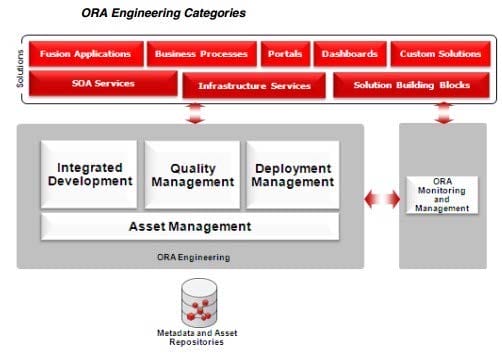Exam Details
Exam Code
:1Z0-574Exam Name
:Oracle IT Architecture Release 3 EssentialsCertification
:Oracle CertificationsVendor
:OracleTotal Questions
:176 Q&AsLast Updated
:Mar 26, 2025
Oracle Oracle Certifications 1Z0-574 Questions & Answers
-
Question 141:
Which of the following capabilities are provided by containers?
A. Transaction Support
B. Security Support
C. Thread Management
D. Business Processes
-
Question 142:
Which of the following is NOT defined as a primary ORA computing foundation component?
A. Distributed Computing
B. Utility Computing
C. Grid Computing
D. Caching
-
Question 143:
Which of the following token profiles is not included in the WS-Security standard as a standard type of identity token?
A. XACML token profile
B. SAML token profile
C. username token profile
D. Kerberos token profile
E. X.500 token profile
-
Question 144:
Which of the following are strategies for alert management with Oracle Enterprise Manager?
A. controlling the volume of alerts
B. removing unwanted alerts
C. centralized filtering of alerts
D. automating fix for common alerts
-
Question 145:
Your company has decided to create an Enterprise Architecture following. The Open Group Architecture Framework (TOGAF). Which option best describes how the IT Strategies from Oracle (ITSO) library of material relates to this TOGAF-based Initiative?
A. ITSO has minimal applicability because TOGAF is a complete architecture framework.
B. The ITSO material can be used as reference material within the TOGAF approach.
C. The TOGAF approach will need to be modified (customized) to incorporate the ITSO material.
D. The ITSO material will need to be adapted to the TOGAF approach.
E. TOGAF and ITSO are mutually exclusive. One or the other must be chosen as the basis for the company's Enterprise Architecture.
-
Question 146:
Oracle Web Services Manager uses an agent-based approach to providing Web Services security. Where are these agents deployed?
A. In any IPv4 of Later network firewall
B. In the Oracle WebLogic Server Web Service request Interceptors
C. In the Oracle Service Bus proxy pipeline
D. In the Oracle Access Manager web gate
E. In the Oracle WebLogic Server access gate
-
Question 147:
The Oracle Reference Architecture (ORA) includes the concept of Technology Perspectives. Which statements are true concerning ORA and Technology Perspectives?
A. Each Technology Perspective focuses on a particular set of products and technology.
B. A Technology Perspectiveincludesboth reference architecture views as well as practical guidance and approaches for successfully implementing the changes required to embrace the products and technology.
C. The Technology Perspectives can be used individually or in combinations, for example, SOA with BI.
D. The Technology Perspectives can be used individually or in combinations. When used in combinations, the SOA Technology Perspective must be included.
E. Each Technology Perspective is part of ORA and is part of an Enterprise Technology Strategy; i.e. a Technology Perspective is the connection between ORA and an Enterprise Technology.
-
Question 148:
Enterprise Architecture consists of Business Architecture, Application Architecture, Information, Architecture and Technical Architecture (BAIT). Which statement best describes Oracle Reference Architecture (ORA) in the context of BAIT?
A. ORA addresses all four (Business, Application, Information, and Technical) equally.
B. ORA is primarily focused on the Technical Architecture, with some content on the other three aspects-of BAIT.
C. ORA has content applicable to the Technical Architecture only.
D. ORA is primarily focused on the Business Architecture, with some content on the other three aspects of BAIT
E. ORA is primarily focused on the information Architecture, with some limited content on the other three aspects of BAIT.
F. ORA has content applicable to Information Architecture only.
-
Question 149:
Which of the following statements are true?
A. (OWCS) provides components for reverse proxy, personalization, customization, social computing, and analytics.
B. Oracle WebCenter (OWC) provides the Resource Tier of the Oracle Reference Architecture User Interaction.
C. Oracle HTTP Server (OHS) provides the standard communication protocols (for example, HTTP) between the Client Tier and the Service Tier as well as the Message Security between the Client Tier and Service Tier.
D. Oracle Meta Data Services (OMDS) stores customization, personalization, and other metadata in a repository
E. Oracle WebLogic Suite (OWLS) is used in Oracle Reference Architecture User Interaction to enable Ontology languages for the Semantic Web
-
Question 150:
Which are the major categories of ORA Engineering capabilities?
A. Integrated Development
B. Asset Management
C. Event Processing
D. Service Engineering
Related Exams:
1Z0-020
Oracle8i: New Features for Administrators1Z0-023
Architecture and Administration1Z0-024
Performance Tuning1Z0-025
Backup and Recovery1Z0-026
Network Administration1Z0-034
Upgrade Oracle9i/10g OCA to Oracle Database OCP1Z0-036
Managing Oracle9i on Linux1Z0-041
Oracle Database 10g: DBA Assessment1Z0-052
Oracle Database 11g: Administration Workshop I1Z0-053
Oracle Database 11g: Administration II
Tips on How to Prepare for the Exams
Nowadays, the certification exams become more and more important and required by more and more enterprises when applying for a job. But how to prepare for the exam effectively? How to prepare for the exam in a short time with less efforts? How to get a ideal result and how to find the most reliable resources? Here on Vcedump.com, you will find all the answers. Vcedump.com provide not only Oracle exam questions, answers and explanations but also complete assistance on your exam preparation and certification application. If you are confused on your 1Z0-574 exam preparations and Oracle certification application, do not hesitate to visit our Vcedump.com to find your solutions here.


